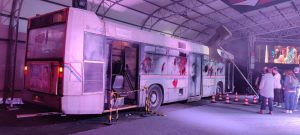DOWNLOAD
All the necessary dependencies are either included in this package or are avaible on the DLS.
The Busotto was introduced by CAM in the mid-1990s as the successor of the company’s Alice model, an urban-type bus that had been introduced in 1990 but saw a lacklustre commercial success.
After the relative failure of the Alice, Autodromo decided to “expand it’s horizons”, opting to search for a foreign partner instead of a domestic one, as had been the standard until then. The choice fell on the german MAN, with wich Autodromo signed a cooperation agreement in the early 1990s. The agreement was centered around the technology transfer for MAN’s low-floor busses, then a rather new development, as low-floor busses were at the time only widespread in Germany and Switzerland, with few other companies (such as the french Renault) only starting then design on their own itteration of the type.
As part of this agreement, MAN provided Autodromo with the frames of it’s NL222 Type low-floor bus and the correlated engine assembly (an in-line six-cylinder 6871cc DO826 LOH15 engine with Voith automatic gearbox) and other mechanical components, while Autodromo built the bodyshell of the bus and assembled it on the frames. The result of this collaboration was the “Busotto” (a name that in Italian is basically an affectionate way of saying “Bus”), introduced in 1994 as Italy’s first mass-produced low-floor bus.
The success of the Busotto was almost immediate, with dozens of transportation companies placing orders, almost overwhelming the relatively small company, wich had been little-known until then. Another factor, besides being the first low-floor bus produced in Italy, contributed to the Busotto’s success: it’s modular design, evidenced by the funky external design with the metal bodyshell covered by plastic-type panels, enabled it to be easily adapted to customer requests.
Thanks to it’s modular design, Autodromo also started to offer the Busotto as a trolleybus, both as a single-unit 12m standard one as well as an 18m articulated version. Busotto trolleybusses were also built on the MAN NL222 chassis, but obviously fitted with different equipment, namely Skoda-built 6ML 3550 K/4 three-phase asyncronous electric motors with a 260Kw/h power output and an IGBT-VVVF traction control system provided by the german Kiepe, with additional electronics built by AdTranz.
The trolleybus version was also rather successful, with eight articulated units (numbered 300 to 307) being purchased by Milan’s ATM in 1999, 35 articulated units (1021-1055) purchased by Bologna around the same time, 14 single units purchased by Parma’s TEP between 1997 and 2000 and 10 articulated units bought by ATCM in Modena, where Autodromo had it’s plant. All of the Busotto-based trolleybusses are capable of running detached from the catenary, as they’re all either fitted with backup batteries, or are full-dual-mode busses (as in the case with the Parma units) fitted with a diesel engine.
Furthemore, using the Busotto design as base, Autodromo introduced on the market two smaller derivatives for less-heavily utilized routes: the 8m-long “Alé” minibus of 1999 and the 10m-long “Tango” medium-bus of 2001. Both models, especially the “Alé” had a good commercial success, being purchased in substantial quantities, altough obviously not comparable to the Busotto itself.
Also in 2001, Autodromo started to offer an upgraded version of the Busotto, the aptly-named “New Busotto”, whose external design was based on the “Alé”. Unfortunately, by that time, due to several factors, such as increasing competition from more well-established manufacturers (especially IVECO, with it’s low-floor CityClass bus was proving to be a formidable competitor) and a sudden shrinkage of the bus market in Italy, due to the early-2000s economic recession worsened the financial status of Autodromo, resulting in the company deeply indebting itself.
Unfortunately, the dire financial situation of the company was worsened by mismanagement issues, and in 2003 Autodromo declared bankruptcy, with the company being dissolved shortly after.
Currently, good amounts of Busottos are still in service thruought Italy, especially the trolleybusses versions wich are the mainstays of all their networks (except for Milano, where due to atrocious maintainance standards, only two Busottos out of eight are currently operable, and are slated for retirement as well). Unfortuantely, even the newest ones are now 20 years old, and many are facing retirement and scrapping, as more and more new busses are introduced.
Depsite the inglorious end, the Busotto has been (and in many cases still is) a key component of many bus fleets, and with it’s distinctive appearance it has carved a special place in the heart of many Italian transportation enthusiasts, earning it the likely title of the most beloved bus in Italy.
Trivia:
As of now, no Autodromo Busottos have been preserved, except one wich is owned by a peculiar group: the Italian cosplayers group of the Umbrella Corporation from the Resident Evil series of videogames!
This is former unit 722 from Padova’s APS, purchased used not too far ago and repainted by the group into a fictional livery, posing as a Racoon City bus.
The bus is capable of running short distances and the electronics are all in working order – warning lights, interior lights, doors and even the LED destination indicators all work perfectly – the latters displaying an appropriate “Racoon City – Alleyway Park” as the destination. Even the original “Arancio Ministeriale” livery can be spotted under the cracks in the paint!
The bus is used as scenic decor during festivals and fairs, such as the Lucca Comics (where the picture below was taken by yours truly) and can be toured inside.

(and of course, this one was the main thing that inspired me to make this busotto pack!)
